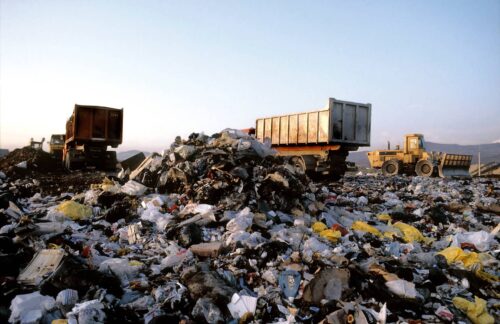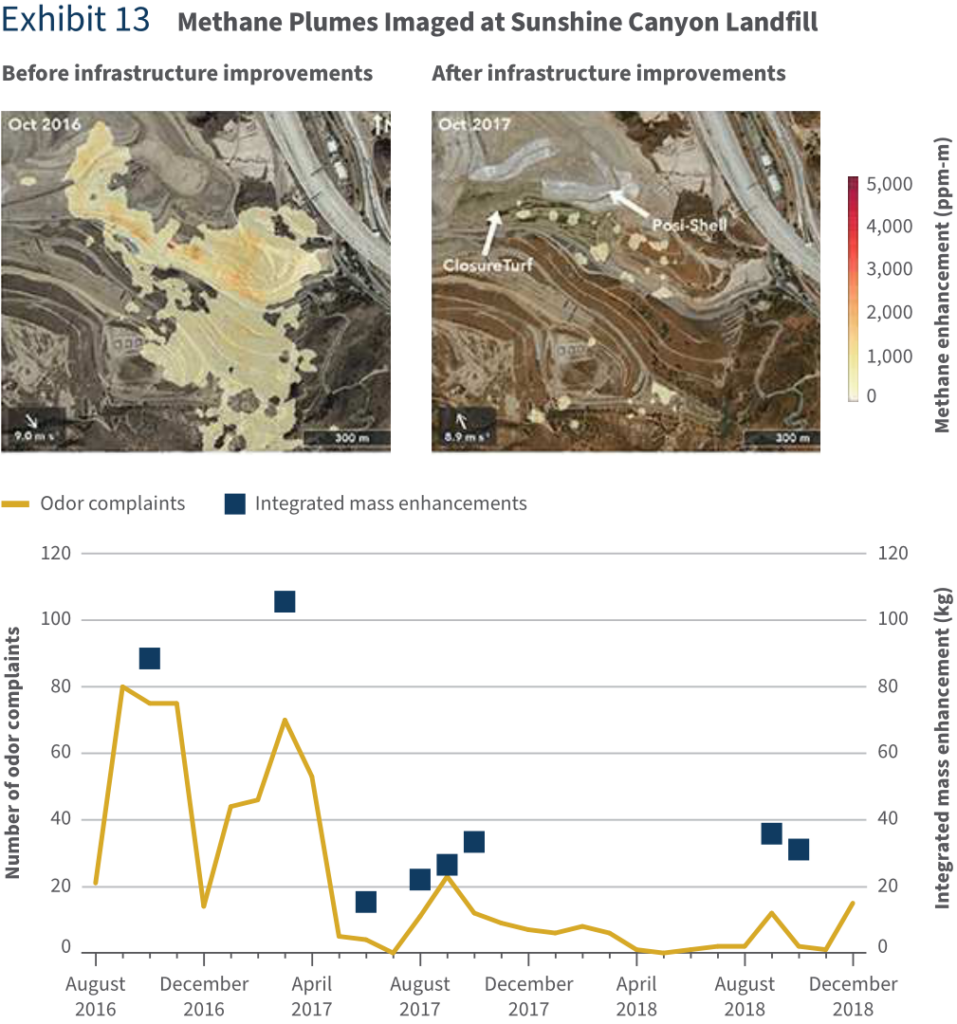
Top Strategies to Cut Dangerous Methane Emissions from Landfills
How smart regulation and tailored policy can cut emissions, lower health risks to nearby communities, and generate clean energy
The need to reduce methane emissions is a growing political imperative. Methane is a super-potent greenhouse gas — over 80 times more powerful than CO2 in its first 20 years — so eliminating emissions can have an outsized benefit in the race to slow global temperature rise. As a result, efforts to curtail methane emissions are multiplying globally.
Most policies targeting methane take aim at the oil and gas sector, one of the largest sources of anthropogenic methane emissions globally. The Inflation Reduction Act (IRA), for instance, includes multiple provisions to reduce methane from the oil and gas sector. The law includes a bold new methane fee that penalizes oil and gas facilities emitting methane above an established threshold; it also provides funding for facility methane mitigation and monitoring.
Exciting as this progress has been, another major source of methane remains largely unaddressed. The waste sector — including solid waste bound for land disposal sites such as household trash and commercial refuse, along with wastewater that has been used for domestic, commercial, or industrial purposes such as laundry, flushing — contributes 18% of all human-caused methane emissions, with solid waste representing 11% of all methane emissions.
Methane from landfills and dumpsites poses more immediate risks, too. Poor methane management can threaten the health and safety of surrounding communities, which are often low-income. Spontaneous combustion at disposal sites can occur due to oxygen intrusion from a variety of factors such as too high vacuum applied to the gas collection system or poor waste compaction, leading to fire and deadly fumes. Meteorological conditions also increase the risk of landfill fires, often made worse by methane which serve as fuel. Outside New Delhi, India’s capital, for example, firefighters recently struggled to douse a huge landfill fire, primed by record heat and fueled by methane.
Solutions are multiplying
Substantial progress is technically feasible. Methane abatement strategies could reduce methane emissions from landfills and dumpsites by 80%, versus business-as-usual emissions, by 2030. This indicates a huge opportunity for policymakers to dramatically reduce the climate impact of waste sector emissions, and advance progress toward meeting targets like the Paris Agreement and the Global Methane Pledge.
A growing ecosystem of comprehensive methane measurement and monitoring strategies is enabling policymakers and regulators to develop data-driven, science-based targets to reduce waste methane emissions. Remote methane observations can now provide data on the precise source and quantity of emissions at the facility level. This makes it easier to hold methane producers accountable, enforce related policies, and pinpoint opportunities for improvement. Independent actors are deploying monitoring technologies to fill data gaps, and governments are stepping up to support the deployment of these technologies to help identify, quantify, and ultimately mitigate methane emissions.
A new report by RMI, Carbon Mapper, IG3IS sheds light on key strategies to reduce waste methane emissions that can be replicated and scaled with the help of intelligent policy. A growing body of case studies illustrate how targeted policy interventions can dramatically reduce the waste sector’s impact on climate change in the near-term.
Diverting organic waste through incentives and educational awareness
Policies can incentivize organic waste diversion through source separation of organic materials, large-scale deployment of organics recovery technologies, and development of organics processing infrastructure. While preventing food loss and waste altogether is preferable, organics diversion, such as large-scale anaerobic digestion facilities, is the next best line of defense in keeping organic materials out of landfills and reducing the burden on downstream mitigation technologies at the disposal site.
Consider Sweden’s progress. In the coastal city of Helsinborg. the Verapark facility treats 160,000 metric tons of source-separated food waste — about 12% of all of Sweden’s food waste. The food waste is co-digested with manure to produce 80 gigawatt-hours of biogas and 145,000 metric tons of fertilizer-grade digestate annually.
Behind this success is a mix of strong waste sector goals and targeted policies at the local, national, and regional level. The Swedish government and the EU have implemented a landfill tax and strong waste-sector goals, including a 50% organics target separation rate, which has led to a strong waste-diversion program. The government also developed a robust educational program on waste sorting for homes and businesses, which increases the throughput of facilities like Verapark.
Rehabilitating Existing Dump Sites to Sanitary Landfills
In many countries, waste is routinely disposed of in unmanaged land disposal sites. Open dumps are typically uncovered and uncompacted sites, often seen in developing countries. Their conditions pose health and safety risks to workers, neighboring residents, and waste pickers who scavenge dumps for valuable materials. Left unmanaged, these sites directly emit methane into the atmosphere.
But smart policies can encourage the conversion of open landfills to safer disposal sites. Policies can, for instance, incentivize the upgrade of unmanaged dumpsites by requiring remediation efforts and/or conversion to sanitary landfills.
India’s 2016 solid waste management rules offer a recent example of how policies can enable dumpsite rehabilitation. The rules mandate the bioremediation or capping of old and abandoned dump sites as well as constructing regional sanitary landfills.
Much remains to be done, as recent fires outside New Delhi attest, but progress is steady. According to the 2020/2021 annual report on the implementation of these rules, a total of 234 dumpsites have been reclaimed/capped, and an additional eight of these dumpsites have been converted to sanitary landfills. Further, an additional 305 landfills have been constructed and 126 are under construction. Policy instruments like India’s solid waste management rules are pivotal in shifting from dump sites to well-managed sanitary landfill systems and can serve as a model for other developing nations to adopt.
Incentivizing Methane Management Best Practices at Existing Sanitary Landfills
Where sanitary landfills exist — commonly in developed economies — policies should require best practices for methane management during design and operations, including comprehensive emissions monitoring.
Without strong directives, many landfill owners and operators will pursue lowest-cost management practices, which may not be the optimal methane mitigation solution. Policy instruments — such as setting methane abatement goals, requiring emissions monitoring, implementing a landfill tax, and creating mitigation incentives — can encourage methane-conscious management in the waste sector.
In California, the Sunshine Canyon landfill offers a compelling case. Just north of Los Angeles, the site sought to improve its management practices in reaction to odor complaints and degrading site conditions.
The effort began in 2009 when, in response to odor complaints, regulators required the landfill operator to institute a non-standard practice of installing a daily cover without peel-back cover. This unintentionally resulted in the flooding of landfill gas wells and ineffective methane capture. Observation flights over Sunshine Canyon landfill found significant plumes of methane – showcasing how ineffective regulatory directives can exacerbate emissions.
In 2017, a more holistic series of methane management practices were rolled out at the landfill. These delivered substantial improvements both in reducing odor and cutting methane emissions. Follow-up methane monitoring flights confirmed a 55-60% reduction in emissions due to the suite of solutions and corroborated by a decline in odor complaints.

This case study demonstrates that a site-specific, holistic approach can deliver dramatic reductions in methane emissions. It also shows that independent atmospheric observations can effectively target methane hotspots and confirm emissions reduction.
Smart, Proactive Policies will Drive Methane Mitigation
Thoughtful and effective policies can orchestrate efforts among key actors in solid waste management including owners, operators, project developers, and financiers to reduce waste methane emissions.
The impact of effective policies on greenhouse gas mitigation cannot be overstated, whether they support food waste prevention, organic waste diversion, dumpsite rehabilitation, optimize the capture of landfill gas, or other effective methane mitigation practices.
Achieving a 1.5oC future is an urgent challenge for this decisive decade. Given the potency of methane and the size of the waste sector’s methane footprint, we must develop effective policies now to drastically reduce waste methane emissions.